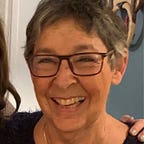Lost in Harlem Without a Cell Phone
Because there weren’t any in 1967
My best friend, Anne, and I were in high school. We had a day off and decided to travel into the city (Manhattan, that is) to spend the day. We had no plans, just to stop when something caught our eye. Neither of us was familiar with the city, generally, traveling there only with our parents. We got dressed up, including heels (I think we wanted to look like businesswomen, but I’m sure we didn’t fool anyone), which was really stupid for walking for hours around the city.
We took the Long Island Railroad to Penn Station, walked out at 7th Avenue, and started walking. Penn Station is at 32nd Street and 7th Avenue, not far from Times Square and the Theater District, just a few blocks uptown at 7th Avenue and Broadway. So, on we walked. Then to Rockefeller Center, Radio City Music Hall, and St. Patrick’s Cathedral around 50th Street and Avenue of the Americas (6th Avenue). None of this was an undoable walk, except that we were in heels! So, we did it slowly, stopped for snacks, and did lots of sightseeing and window shopping along the way.
We had arranged to drive home with my father after he finished work, so we decided to take a slow stroll to his store on 98th Street and Lexington Avenue on the Upper East Side. That is a long walk, but the Upper East Side is classy, safe, and has some great stores. And we had plenty of time until 6 PM.
We weren’t far from the southern end of Central Park, and even as New Yorkers, we had never walked it, so we thought we’d stroll uptown through the park and then head over to Lexington Avenue. If you know New York, you know that it’s laid out as a grid — streets running east and west, avenues north and south — so it’s not hard to get around. Central Park, we discovered, is like a bowl of spaghetti. Following a road does not get you out of the park except by sheer luck! And, you could just as easily wind up on the west side instead of the east side, or as we did, as we found out that we had walked the entire length of the park, on the north side — smack dab in the middle of Harlem.
Harlem in the 1960s was a scary place for two teenage white girls — or at least, we were scared. Everything in Harlem was boarded up or broken down, and there were groups of black boys in clusters on street corners and stoops. No one made a move towards us, but we were frightened that they could.
Some explanation about us and the times: Our high school was in a totally segregated area of Long Island (not by law, of course, but by happenstance and, likely, preference). There were no black kids in our school or anywhere in the district. This was during the height of the Civil Rights Era, and I was very vocal about the necessity for equal rights. It was easy for me to be vocal, living with my white family in my white house in my white neighborhood and never really putting myself in the shoes of those who had less than me. I had no idea what their lives were really like.
So here we were, totally lost and very scared. “We need to find a store and make a phone call to my father. He’ll come save us.” (I’m sure I said he’d save us and not just get us!)
We didn’t even want to ask one of the boys on the street for fear that we’d awaken some dangerous propensity in them! So we walked, hoping to find someplace to make a phone call, and finally found an open candy store. We walked in (by this time, we both were limping from our sore feet) and were directed to a pay phone, where we called my father, who told us to sit tight; he’d be there as soon as he could be.
Candy stores don’t just sell candy; they are also soda fountains, newspapers and magazines, stationery and school supplies, and sometimes over-the-counter medicines. So, you could expect adults in them and not just kids. The place was full of middle-aged and old men, just talking and watching us. There was no place to sit tight, as my father had suggested, so we tried to push ourselves against the wall to blend into the woodwork!
Finally, to avoid leaving his car unattended, my father beeped his horn. We walked to the door, and Anne said, “Thanks for keeping an eye on us,” with a little smile as we walked out of the store!
Who would have imagined that years later, had this same thing happened, I’d have been able to use my cell phone to get walking directions through Central Park or to call my father to pick us up before we ever made it to Harlem.
— — — — — —
(Jan wants to apologize for anything she wrote that sounds racist. It was a different time and Harlem was a very different place than Long Island. And we didn’t know better.)
